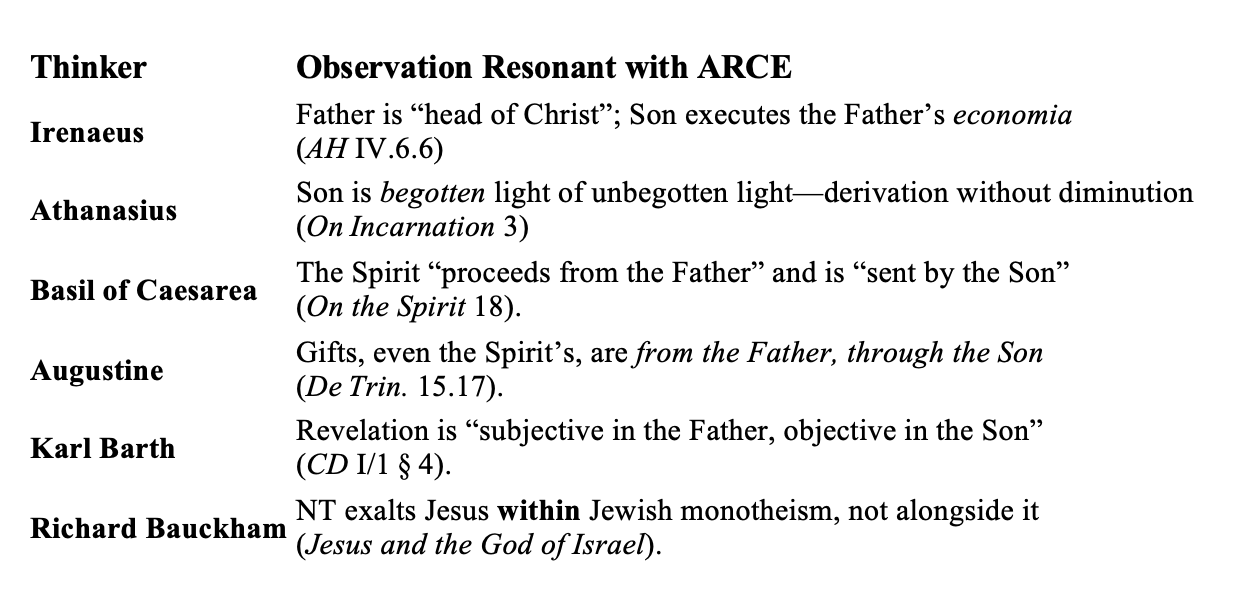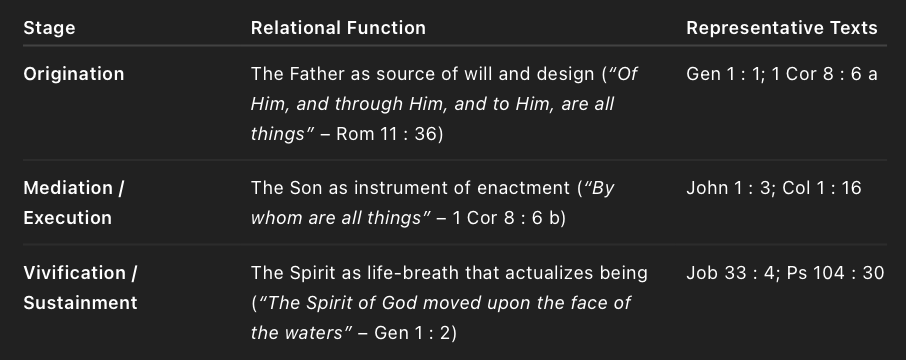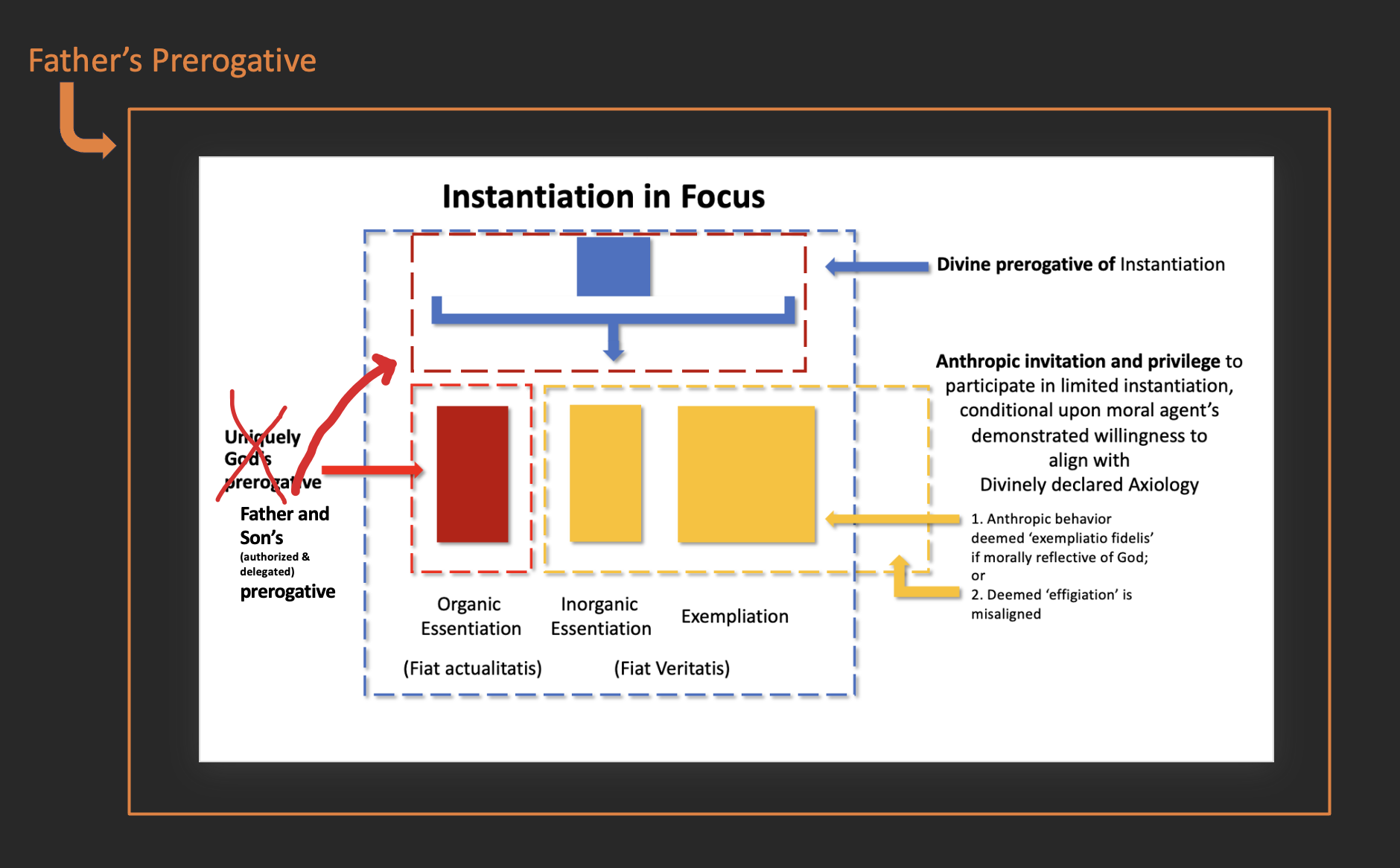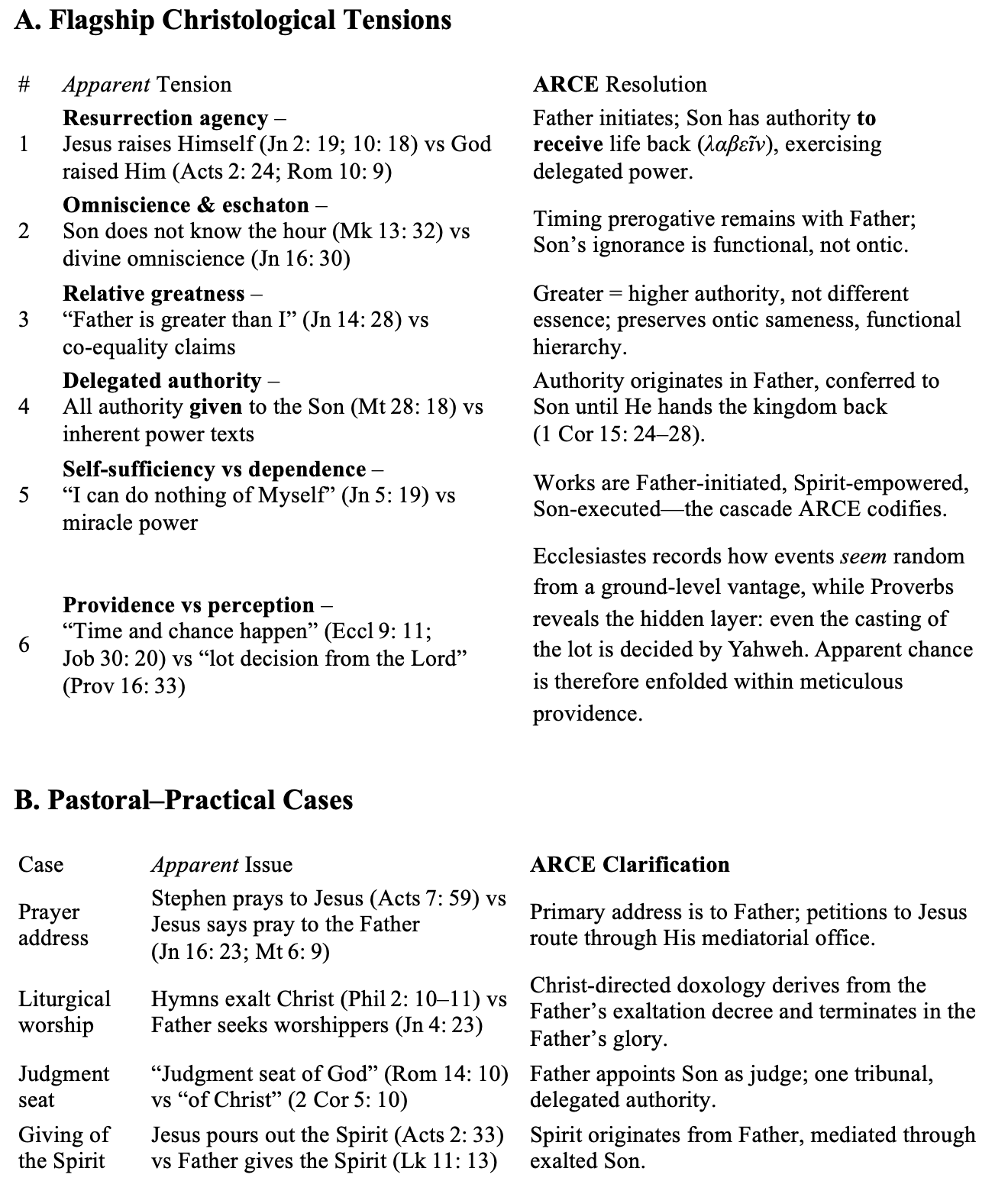Contradictions in Scripture are rarely textual; they are almost always relational. When readers meet apparent clashes—say, “I will raise it up” (John 2 : 19) versus “God raised Him” (Acts 2 : 24)—the reflex is to treat every verse as if it spoke from the same vantage point. This “flat proof‑text” habit persists from reverence (no‑one wishes a canon‑within‑the‑canon) and from the caution famously voiced by Warfield and later echoed in many evangelical statements of inerrancy. The net result, however, is doctrinal fog or appeals to mystery where Scripture offers clarity.
This essay proposes the Axiom of Relational‑Constraining Exegesis (ARCE) as a remedy. ARCE honours plenary inspiration without erasing the God‑ordained hierarchy Scripture itself displays—Father → Son → Spirit → creation. By granting interpretive priority to relationally primary agents, ARCE lets derivative voices speak in context, dissolving tensions while preserving every text.
ARCE refines classic hermeneutics such as analogia Scripturae (“Scripture interprets Scripture”) and analogia fidei (“in harmony with the rule of faith”). It stands on the relational‑ontological ground laid in Appendix A —substantive onto‑homogeneity (Son shares the Father’s kind of being) and distinct onto‑relationality (Son’s role is functionally subordinate). With that foundation in place, we now articulate the axiom and trace its reach.
Axiom. When multiple inspired statements address the same event, act, or truth‑claim from differing relational vantage points, the witness of ontologically and relationally primary agents (e.g., the Father) constrains—i.e., governs and contextualises—the statements of derivative agents (e.g., the Son, the Spirit, angelic messengers, human authors).Rule of thumb: Let ontological primacy set interpretive priority.
Primary vs Derivative. Primary agents possess auctoritas essendi and auctoritas instantiandi—authority of being and of enactment. Derivative agents act within that delegated domain.
Scope. ARCE applies across both Testaments, all genres, and every doctrinal locus where agency attribution varies.
Outcome. Apparent tensions are harmonised without flattening distinct voices and without resorting to speculative dual natures.
The Father alone is portrayed as possessing underived life (John 5 : 26) and as originating every decisive redemptive act (Acts 2 : 24; 1 Cor 15 : 24–28). The Son shares the kind yet receives life, judgment, and kingdom from the Father (John 5 : 22; Luke 1 : 32–33). The Spirit proceeds from the Father through the Son (John 15 : 26; Acts 2 : 33). ARCE simply lets this ontological cascade guide exegesis.
Key Text Cluster – John 5 : 19–26; John 14 : 28; Acts 2 : 24–33; 1 Cor 15 : 24–28; Heb 1 : 1–4.
Biblical writers already privilege divine speech over creaturely experience. Qoheleth laments randomness (Eccl 9 : 11), yet Proverbs 16 : 33 asserts hidden providence. Gospel writers let the Father’s baptismal voice frame every later Christological claim. ARCE is therefore an explicit articulation of an implicit biblical habit.
Analogia Scripturae affirms Scripture interprets Scripture—ARCE specifies which voices hold veto power. Analogia fidei maintains harmony with the rule of faith—ARCE supplies the ontological logic behind that harmony. Canonical reading recognises unity—ARCE guards order within that unity.

ARCE does not diminish the Son or the Spirit; it honours their roles by reading them as Scripture presents them—relationally subordinate yet ontologically divine. Nor does it create a “canon‑within‑the‑canon”; every verse remains fully authoritative, though interpretive control follows revelational order. This alignment respects the Father’s exclusive prerogative to initiate and authorize:
“Who is he that saith, and it cometh to pass, when the Lord commandeth it not?” (Lamentations 3:37)
Causality is never presumed apart from divine command—preserving harmony, not hierarchy collapse.
A further and salvific corollary follows from this cascade. Because the Father alone possesses auctoritas essendi and auctoritas instantiandi, He is the sole Provider—the fountain of being, grace, forgiveness, and every answered petition. The Son, though of the same ontic kind, functions solely as Mediator of access, not as parallel source.The Spirit, proceeding from the Father through the Son, vivifies participation, not origination.
Hence the entire redemptive and prayer economy is Father-centred:
To the Father, through the Son, in the Spirit.
Petitions or worship directed to the Son or to the Spirit, though devout in appearance, invert the salvific vector. They address the intermediary as source, bypassing the Father’s prerogative and thereby nullifying access. Such prayer has no ontological footing; it is as those of whom Christ said, “He that climbeth up some other way, the same is a thief and a robber” (John 10 : 1).No entry is granted outside the appointed Gate, for that Gate is the Son—not the destination.
When Christ prays, “Father, glorify Thy Name” (John 12 : 28), or commands, “When ye pray, say, Our Father” (Luke 11 : 2), He is not modelling humility only; He is revealing the salvific order of relation.Likewise, “Whatsoever ye shall ask the Father in My Name, He will give it you” (John 16 : 23) grounds all communion in paternal provision.
Therefore, ARCE constrains both interpretation and redemption:
All provision and pardon originate with the Father.
All access and mediation reside in the Son.
All participation and renewal are effected by the Spirit.
Any system that prays to Christ or to the Spirit misconstrues the divine order and, in practice, petitions an intermediary rather than the source—and will effectively be ignored, for as the parable warns of those who “climb up some other way” (John 10:1), no access is granted outside the appointed gate. Relational fidelity in prayer thus mirrors ontological fidelity in being.
Note: Divine order is immutable, yet accountability corresponds to revelation. The Father may grant provisional access under partial understanding, until fuller truth is disclosed and moral alignment becomes requisite, otherwise it is tantamount to rebelliousness to revealed truth.
The same order that governs prayer and petition governs creation itself. That the Son “made all things” (John 1:3; Col 1:16) does not imply autonomous causation but delegated enactment under the Father’s auctoritas instantiandi. The Father conceives and authorizes; the Son executes and manifests; the Spirit animates and sustains. Thus, creation itself reveals the same triadic economy operative in redemption:

In this order, Christ’s creative work is not rival sovereignty but faithful execution of delegated divine authorship. He acts with derived authorization, not self-origination. This same relational pattern defines creation, redemption, intercession, and prayer alike. Autonomy is never creative nor salvific; delegated fidelity is the very form of divine action.
Our earlier schematic in Ontology Part I , can now be refined in light of the relational and soteriological hierarchy just established. The following diagram restates the structure of instantiation within the Divine Ontological Order with greater accuracy, showing that all ontic participation unfolds within the Father’s prerogative.
Whereas the Son shares the Father’s substantive ontohomogeneity, His ontorelational participation remains delegated—He acts as Mediator of the Father’s will, not as an autonomous source. Accordingly, the outer boundary of the diagram now represents the Father’s overarching prerogative of instantiation, within which the Son exercises filial co-participation (“the Father and Son’s prerogative”), and moral agents are conditionally invited to exemplify fidelity in bounded domains.
This reconstruction therefore visualises, in ontological form, the same salvific order expressed in the preceding corollary:
From the Father — through the Son — by the Spirit — unto the creature.

Revised Ontological Schema of Instantiation within the Father’s Prerogative
The Father’s prerogative encloses all domains of being.
The Son’s prerogative is filial and delegated within it.
Anthropic exemplification is contingent and moral.
The miracles of the feeding of the thousands (Matt 14 : 13–21; 15 : 32–39) and the Sermon on the Mount (Matt 5 – 7) each disclose the same ontorelational order that ARCE safeguards. In both, the Father provides—life, sustenance, moral order—and the Son mediates that provision into the created realm.
When Christ blesses the loaves, He does not produce bread ex nihilo as an independent agent; He receives from the Father’s plenitude and distributes it in filial obedience:
“He looked up to heaven, blessed, and brake.” (Matt 14:19)
The upward glance is not symbolic only; it is relational — the visible acknowledgment that supply flows from the Father, not from the incarnate instrument.
Likewise, the Sermon on the Mount reveals that all ethical and existential security lies in paternal providence:
“Your heavenly Father knoweth that ye have need of all these things.” (Matt 6 : 32)
Christ’s speech is mediatorial speech — He declares what the Father wills.
The Sermon is therefore not moral innovation but the transmission of paternal axiology into human hearing.
These acts and words together manifest the ontology of provision:
The Father is the source.
The Son is the mediator.
The Spirit is the witness.Every loaf broken and every word spoken carries that same relational imprint — delegated actualitas in the service of filial fidelity.
At Bethany, the Son discloses in act what ARCE defines in principle. Standing before the tomb, He prays aloud—not for private communion but for public revelation:
“Father, I thank Thee that Thou hast heard Me. And I knew that Thou hearest Me always; but because of the people which stand by I said it, that they may believe that Thou hast sent Me.”
In that utterance the entire relational order is laid bare:
Acknowledgment of Source — The Son attributes both hearing and causal power to the Father: "Thou hast heard Me."
Revelation of Mediation — He prays for the onlookers’ sake, displaying that the miracle flows through the Son but from the Father.
Delegated Actualitas — When He cries, “Lazarus, come forth,” the command constitutes the execution of the Father’s will, not autonomous origination.
Resurrection therefore proceeds within the same triadic economy:
The Father provides life, the Son mediates its manifestation, the Spirit actualizes its vitality.
The episode stands as the definitive witness that even creative and restorative acts occur inside the Father’s prerogative of instantiation. Christ’s glory is filial fidelity, not independent sovereignty; His prayer reveals the order by which all divine action proceeds.

Christological clarity – Avoids modalism and Nicene flattening. See Appendix A.
Coherent doctrine of providence – Marries human phenomenology with divine causation.
Exegetical consistency – Replaces proof‑text ping‑pong with principled hierarchy.
Pastoral guidance – Clarifies prayer, worship, eschatology, authority.
Pedagogical simplicity – One heuristic usable from devotionals to undergraduate hermeneutics classes.
Ontological equality affirmed – No Arian slide.
No radical sub-ordinationism – Son’s obedience magnifies His glory (Phil 2 : 9–11).
Canon‑within‑canon critique answered – Hierarchy is descriptive, not imposed.
ARCE offers one clarifying lens: interpret from the top down—the Father (The One True God), the only begotten Son, the Spirit, creation. By respecting Scripture’s relational order, the axiom preserves every verse and resolves apparent contradictions.
“Let ontological primacy set interpretive priority.”
May this principle guide your reading and teaching this week—and may the contradictions shrink.
